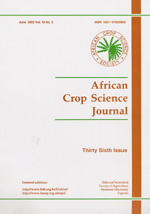
|
African Crop Science Journal
African Crop Science Society
ISSN: 1021-9730
EISSN: 1021-9730
Vol. 28, No. 1, 2020, pp. 79-92
|
 Bioline Code: cs20007
Bioline Code: cs20007
Full paper language: English
Document type: Research Article
Document available free of charge
|
|
|
African Crop Science Journal, Vol. 28, No. 1, 2020, pp. 79-92
| en |
Analysis of grain yield components of selected upland rice grown in valley bottom soil under rates of foliar ortho-silicate acid fertiliser
Olagunju, S.O.; Sakariyawo, O.S.; Atayese, M.O.; Dare, E.O.; Nassir, A.L. & Adesina, E.H.
Abstract
Attainment of potential yield (PY) of upland rice grown in valley bottom (VB) soil is limited by inadequate supply of beneficial nutrients. Previous study revealed that VB soil increase grain weight plant-1 (GWP) in upland rice by 70%, which is still far below its PY. Application of ortho-silicate acid (OSA) fertiliser, as silicon source at optimum rate, could help to boost the yield of upland rice. Five upland rice cultivars, comprising of three medium maturing (NERICA 1,4,7) and late maturing (MOROBEREKAN and OFADA), were grown in pots filled with VB soil. Four rates of foliarly applied OSA fertiliser (0, 250, 500, and 750 ml ha-1) were imposed across stages of growth of rice cultivars. OSA fertiliser increased GWP significantly (P<0.01) with application of 500 ml ha-1 having the best effect. At 250 ml ha-1, 1000 grain weights was more associated with number of branches panicle-1 and number of grains branch-1 panicle-1; while at 500 ml ha-1, GWP was closely associated with % number of fertile spikelets panicle-1 plant-1 (%NFSPP), total weight of panicle plant-1 (TWPP) and length of panicle plant-1 (LPP). Total number of spikelets plant-1 was more associated with total number of panicle plant-1 at 750 ml ha-1. The highest significant (P<0.01) GWP was observed in MOROBEREKAN (9.27 g plant-1); while the lowest was in Ofada (4.79 g plant-1). Application of 500 ml ha-1 of the fertiliser is recommended for these rice cultivars. Further improvement in yield of upland rice grown on VB soil under foliarly applied silicon should focus on % NFSPP, TWPP, and LPP.
Keywords
Foliar application; OSA fertiliser; upland rice; yield components
|
| |
| fr |
Olagunju, S.O.; Sakariyawo, O.S.; Atayese, M.O.; Dare, E.O.; Nassir, A.L. & Adesina, E.H.
Résumé
L’atteinte d’un rendement potentiel (RP) de riz pluvial cultivé dans le sol de fond de vallée (FV) est limitée par un apport insuffisant de nutriments bénéfiques. Une étude précédente a révélé que le sol de fond de vallée (VB) augmente le poids de grain par plante (PGP) dans le riz pluvial de 70%, ce qui est encore bien en dessous de son rendement potentiel (RP). L’application d’engrais d’acide orthosilicate (AOS), comme source de silicium à un taux optimal, pourrait aider à augmenter le rendement du riz pluvial. Cinq cultivars de riz pluvial, comprenant trois à maturation moyenne (NERICA 1,4,7) et à maturation tardive (MOROBEREKAN et OFADA), ont été cultivés dans des pots remplis de terre FV. Quatre taux d’engrais AOS appliqués par voie foliaire (0, 250, 500 et 750 ml ha-1) ont été imposés à tous les stades de croissance des cultivars de riz. L’engrais AOS a augmenté PGP de manière significative (P <0,01) avec l’application de 500 ml ha-1 ayant le meilleur effet. À 250 ml ha-1, 1000 poids de grain étaient davantage associés au nombre de branches par panicule et au nombre de grains par branche et par panicule; alors qu’à 500 ml ha-1, PGP était étroitement associé au% nombre d’épillets fertiles par panicule et par plante (% NEFPP), au poids total de la panicule par plante (PTPP) et à la longueur de la panicule par plante (LPP). PGP significatif le plus élevé (P <0,01) a été observé à MOROBEREKAN (9,27 g plante-1); tandis que le plus bas était à Ofada (4,79 g de plante-1). L’application de 500 ml ha-1 d’engrais est recommandée pour ces cultivars de riz. Une amélioration supplémentaire du rendement du riz pluvial cultivé sur le sol FV sous silicium appliqué par voie foliaire devrait se concentrer sur le% NEFPP, PTPP et LPP.
Mots Clés
Application foliaire; engrais OSA; riz pluvial; composants de rendement
|
| |
© Copyright 2020 - African Crop Science Society
|
|
